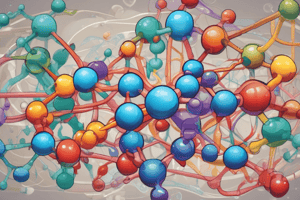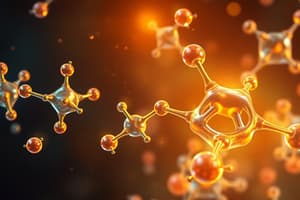Podcast
Questions and Answers
Which of the following statements about proteins is correct?
Which of the following statements about proteins is correct?
- Proteins serve primarily as energy storage molecules.
- Proteins are formed by glycosidic bonds between amino acids.
- Proteins are composed of fatty acid subunits.
- Proteins must be folded correctly to function optimally. (correct)
Which type of bond links nucleotide monomers in nucleic acids?
Which type of bond links nucleotide monomers in nucleic acids?
- Phosphodiester bonds (correct)
- Peptide bonds
- Hydrogen bonds
- Glycosidic bonds
What is the main function of carbohydrates in living organisms?
What is the main function of carbohydrates in living organisms?
- Energy for metabolism (correct)
- Carrying genetic information
- Facilitating chemical reactions
- Providing structural support
Which of the following accurately describes the function of lipids?
Which of the following accurately describes the function of lipids?
Which type of metabolism is characterized by building molecules and requires an input of ATP?
Which type of metabolism is characterized by building molecules and requires an input of ATP?
How do enzymes lower the activation energy of a reaction?
How do enzymes lower the activation energy of a reaction?
What occurs during the termination step of enzyme catalysis?
What occurs during the termination step of enzyme catalysis?
In what scenario would an enzyme not function properly?
In what scenario would an enzyme not function properly?
What characterizes the cell membranes of animal cells?
What characterizes the cell membranes of animal cells?
What type of molecules diffuse across a cell membrane most easily?
What type of molecules diffuse across a cell membrane most easily?
How do aquaporins facilitate water movement across cell membranes?
How do aquaporins facilitate water movement across cell membranes?
Which of the following best describes exocytosis?
Which of the following best describes exocytosis?
What defines eukaryotic cells in contrast to prokaryotic cells?
What defines eukaryotic cells in contrast to prokaryotic cells?
What role do lysosomes play in the cell?
What role do lysosomes play in the cell?
Flashcards
Types of Macromolecules
Types of Macromolecules
Four major organic molecules essential for life: proteins, nucleic acids, carbohydrates, and lipids.
Proteins
Proteins
Macromolecules that perform critical reactions and provide structure in cells; composed of amino acids linked by peptide bonds.
Nucleic Acids
Nucleic Acids
Macromolecules that carry genetic information and energy carriers; composed of nucleotides linked by phosphodiester bonds.
Carbohydrates
Carbohydrates
Signup and view all the flashcards
Lipids
Lipids
Signup and view all the flashcards
Metabolism
Metabolism
Signup and view all the flashcards
Catabolism
Catabolism
Signup and view all the flashcards
Anabolism
Anabolism
Signup and view all the flashcards
Enzymes
Enzymes
Signup and view all the flashcards
Induced Fit Model
Induced Fit Model
Signup and view all the flashcards
Active Site
Active Site
Signup and view all the flashcards
Cell Membrane Components
Cell Membrane Components
Signup and view all the flashcards
Diffusion
Diffusion
Signup and view all the flashcards
Osmosis
Osmosis
Signup and view all the flashcards
Eukaryotic Cells
Eukaryotic Cells
Signup and view all the flashcards
Study Notes
Types of Macromolecules
- Four major organic molecules are essential for life processes: proteins, nucleic acids, carbohydrates, and lipids.
- Molecules are primarily large polymers composed of repeated simpler units (monomers/subunits) connected by covalent bonds.
Proteins
- Function: crucial for critical reactions, cell structure, and support
- Monomer subunit: amino acid subunits
- Bond type: peptide bonds (carboxyl and amino group)
Nucleic Acids
- Function: energy carriers and genetic information storage in nucleotides.
- Monomer subunit: nucleotide monomers
- Bond type: phosphodiester bonds
Carbohydrates (Sugars)
- Function: energy for metabolism
- Monomer subunit: monosaccharides (linear/cyclic molecules with 5-6 atoms)
- Bond type: glycosidic bonds
- Additional notes: monosaccharides form complex carbohydrates (disaccharides and polysaccharides)
Lipids
- Shared feature: hydrophobic components
- Function of fats: energy storage
- Function of steroids: components of animal plasma membranes, and signalling molecules
- Function of phospholipids: major component of cell membranes
Metabolism and Enzymes
- Metabolism: chemical reactions converting molecules and transferring energy in living organisms.
- Two types of metabolism:
- Catabolism: breaking down molecules into smaller units, produces ATP.
- Anabolism: building molecules from smaller units, requires ATP.
- Enzymes: biological catalysts that speed up chemical reactions.
- Help overcome hurdles of reactant collisions and sufficient kinetic energy.
- Bring substrates together at the active site (substrate binding site)
- Help substrates collide with the correct orientation for reactions.
- Lower activation energy: stabilize transition state
Enzymes (Continued)
- Enzymes catalyse a single reaction with high specificity.
- Transition state: intermediate unstable state during reaction.
- Activation state: energy required for a reaction to occur.
- Enzymes lower activation energy to facilitate the reaction.
- Three-step process of catalysis:
- Initiation: reactants bind to the active site.
- Transition state: interactions between enzyme and substrate.
- Termination: products have lower affinity for the active site, and molecules leave.
- Know Catalyzed vs Uncatalyzed Reaction Curves
- AG: Represents change in free energy.
- Enzyme Saturation: Active sites are all filled.
- An enzyme's activity is sensitive to conditions. Misfolded from heat or cold.
- Range of pH that enzymes work in
- Enzyme Regulation
- Noncovalent modifications (molecules that bind enzyme somewhere to change its conformation).
- Competitive inhibition: inhibitor molecule mimics substrate, blocking active site.
- Allosteric regulation: molecule binds somewhere other than the active site, altering shape of the enzyme and thus changing its activity or location in the cell.
- Inhibition: enzyme's active site not available, enzyme is no longer active.
Cell Membranes
- Selective barrier, helps maintain homeostasis
- Animal cells have only cell membrane, plants have cell membrane and cell wall.
- Three major components:
- Phospholipids are major component of cell membrane
- Proteins
- Carbohydrates
- Cell membrane is amphipathic: hydrophilic and hydrophobic components; spontaneously form structures in water.
- Properties affect how molecules move across membrane:
- Miciles
- Bilayer
- Small nonpolar molecules (CO2)
- Small uncharged polar molecules (water, glycerol)
- Large uncharged polar molecules (glucose, amino acids)
- lons (sodium ions)
Movement Across Cell Membranes
- Simple diffusion: solutes move from high to low concentration.
- Osmosis: the movement of water across a membrane.
- Isotonic, Hypertonic, Hypotonic
Membrane Proteins
- Membrane proteins assist in facilitated diffusion.
- Channels and carriers (passive transport)
- Active transport: requires ATP
Eukaryotic Cells
- Nucleus: contains genetic material
- Organelles: specialized compartments for specific functions.
- Endomembrane system (ER, Golgi, lysosomes): interconnected network for protein synthesis, modification, and transport.
- Cytoskeleton: helps maintain cell shape and facilitate movement.
- Endocytosis
- Exocytosis
Evolution of Multicellularity
- Unicellular eukaryotes stick together to form colonies
- Complex multicellular organisms have: cell adhesion, cell communication, and complex patterns of cellular and tissue differentiation.
- Cadherins: proteins that enable cells to stick to each other.
- Integrins: link cells to the extracellular matrix.
- Pectin: a plant polysaccharide for adhesion.
Studying That Suits You
Use AI to generate personalized quizzes and flashcards to suit your learning preferences.




